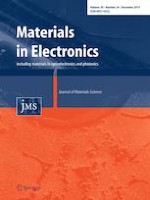13-11-2019
Copper doping of Sb2S3: fabrication, properties, and photovoltaic application
Published in: Journal of Materials Science: Materials in Electronics | Issue 24/2019
Log inActivate our intelligent search to find suitable subject content or patents.
Select sections of text to find matching patents with Artificial Intelligence. powered by
Select sections of text to find additional relevant content using AI-assisted search. powered by
